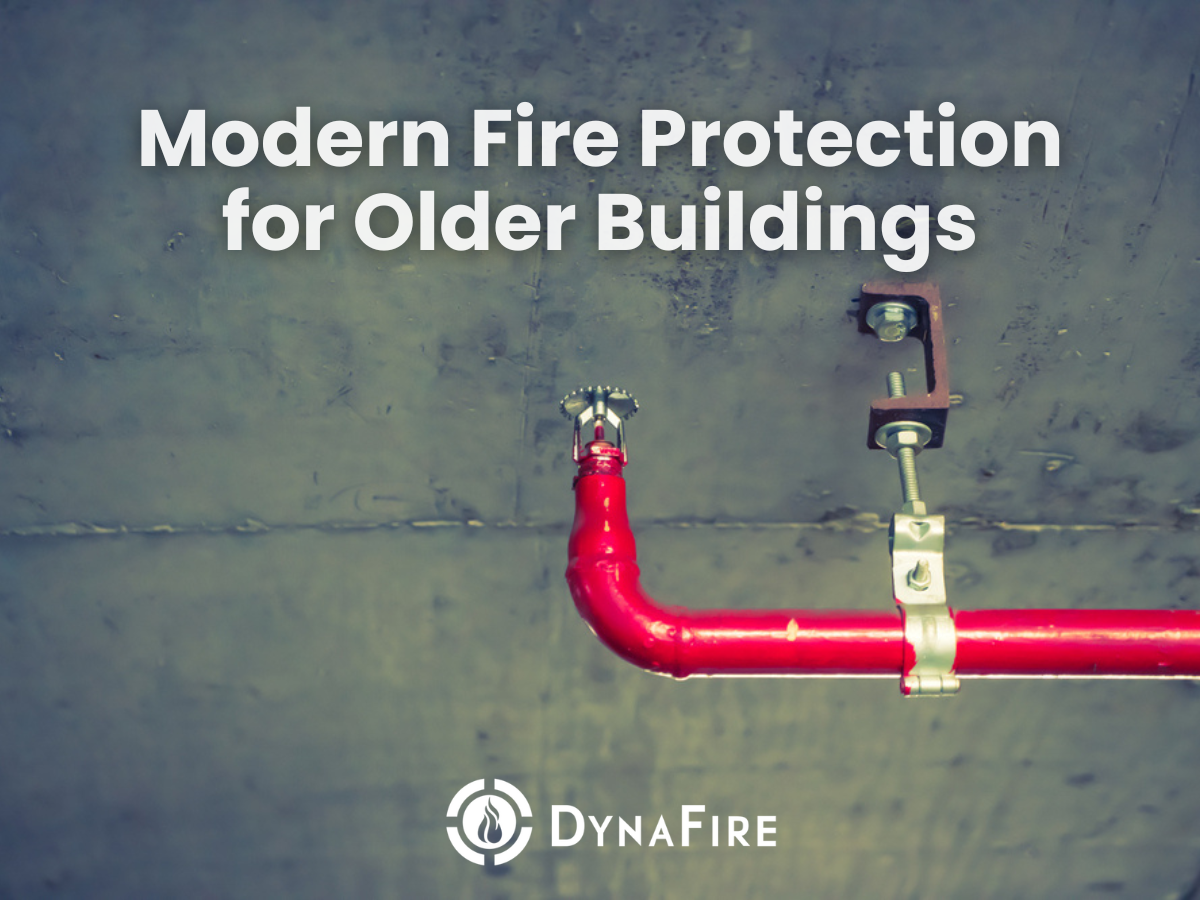Retrofitting fire protection systems helps aging commercial buildings meet modern safety codes. Learn what’s involved, why it matters, and how to get started.
Do older buildings need updated fire protection systems? In many cases, yes—and retrofitting is how you make it happen. As commercial buildings age, the fire safety infrastructure that once met code may no longer provide adequate protection. Whether it’s because fire codes have evolved, tenants have changed, or the system is simply outdated, retrofitting fire protection systems is the key to keeping people safe and properties compliant.
Here’s what retrofitting involves, why it’s necessary, and how DynaFire can help.
Why Retrofitting Fire Protection Systems Is Critical in Older Buildings
If your commercial building is more than 20–30 years old, chances are it was built under very different fire safety standards than those in place today. Fire codes are constantly evolving to address new materials, technologies, and occupancy types. That means older systems may fall short, both in terms of functionality and compliance.
Retrofitting isn’t just about following rules. It’s about protecting your investment and everyone who enters your building. Older infrastructure may pose serious fire risks, and insurance providers often require updated systems to maintain coverage.
Some key reasons to consider a retrofit:
- Outdated systems that no longer meet local or national code
- Building renovations or occupancy changes that affect fire safety needs
- Limited or missing coverage in high-risk areas
- Pressure from insurers, AHJs, or corporate safety teams to bring systems up to modern standards
What’s Involved in Retrofitting Fire Protection Systems
Retrofitting starts with a comprehensive review of your current system and building layout. From there, fire safety engineers design a solution that meets both code and the building’s physical constraints. Unlike new construction, retrofits require creativity, precision, and deep knowledge of fire protection systems.
Depending on the condition of your building, the retrofit may include:
- Installing or upgrading sprinkler systems in areas that previously lacked coverage
- Replacing outdated control panels and initiating devices with modern, addressable components
- Adding strobes, horns, or voice evacuation systems to meet current egress and ADA requirements
- Implementing 24/7 monitoring for immediate response and reduced liability
- Enhancing water supply systems with fire pumps or backflow preventers where needed
Every retrofit project is custom—what works in a shopping center may not work in a mid-rise office or manufacturing facility. That’s why it’s essential to work with a team that has extensive retrofit experience.
Common Challenges When Retrofitting Older Buildings
Fire protection retrofits are rarely straightforward. Older buildings weren’t designed with today’s systems in mind, and they often pose unique hurdles that demand expert planning.
Here are some of the biggest challenges:
- Tight ceiling or wall space can limit the placement of pipes and wiring.
- Hazardous materials, such as asbestos, may delay work or require abatement.
- Occupied buildings require careful coordination to minimize disruption and ensure a seamless transition.
- Historic structures may limit the options for upgrading systems and their placement.
- A lack of accurate building plans makes the design process more complex and time-consuming.
These challenges make it even more critical to partner with a fire protection provider that knows how to navigate old buildings without compromising safety or code compliance.
Benefits of Retrofitting Fire Protection Systems
Despite the complexities, retrofitting offers significant benefits for both building owners and tenants in the short and long term. In addition to staying on the right side of regulations, a retrofit can boost your building’s value, reduce false alarms, and provide peace of mind in an emergency.
Here’s what you gain with a properly executed retrofit:
- Code compliance and reduced risk of fines or shutdowns
- Improved safety for occupants and emergency personnel
- Greater insurability and fewer fire-related insurance claims
- Modern technology that improves system reliability and performance
- Future-proofing against upcoming code changes and tenant needs
When fire protection systems work as they should, people notice. Tenants feel more secure. Investors see value. And owners reduce risk.
Why Your Retrofit Partner Matters
Not all fire protection contractors are experienced in retrofitting, especially in complex, multi-tenant, or high-occupancy commercial properties. A successful retrofit requires more than just technical skill. It demands communication, coordination, and a thorough understanding of fire codes and construction.
When selecting a partner, look for:
- In-house engineering and NICET-certified technicians
- Experience working in occupied or restricted environments
- Strong relationships with local AHJs to streamline approvals
- Full-service capabilities, including design, installation, inspection, and monitoring
Choosing the right team can make the difference between a smooth, timely retrofit and a frustrating, costly one.
DynaFire Is Your Partner in Fire Protection Retrofits
At DynaFire, we specialize in retrofitting fire protection systems for commercial buildings across Florida. Whether your property is 30 years old or 130, we can help you modernize your life safety systems while minimizing disruption to your operations.
We don’t just install sprinklers or alarms—we create custom, code-compliant solutions that protect people and property every hour of every day.
If your building needs a fire protection upgrade, let’s talk. Our experienced team will assess your current system, outline your options, and design a retrofit plan that works with your building’s structure, schedule, and budget. Contact us today to schedule a consultation and take the first step toward a safer, code-compliant building.






